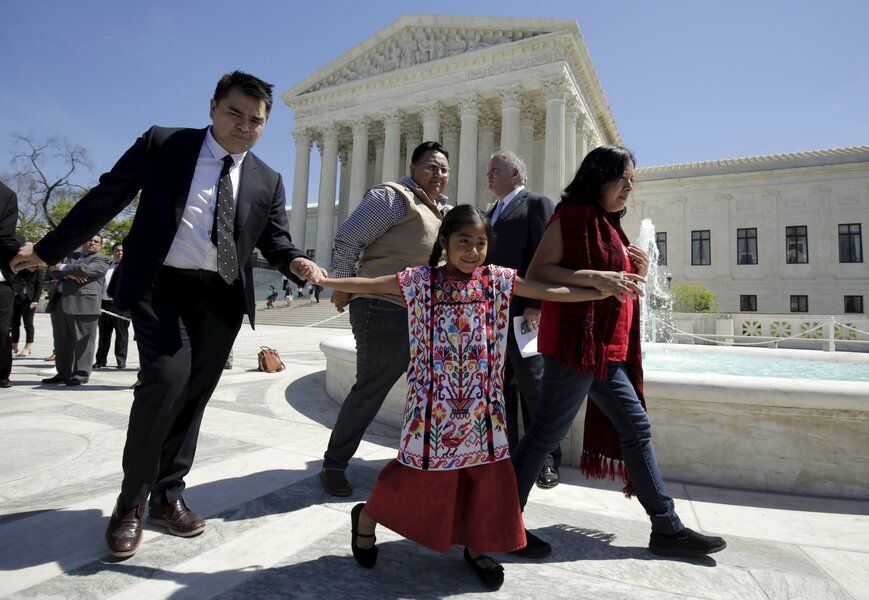The big, overlooked question in Supreme Court immigration case
Loading...
| Washington
For many Americans, the most immediate concern about the case the Supreme Court heard on Monday is what effect it will have on President Obama's attempt to reform United States immigration law and provide relief to more than 4 million undocumented immigrants.
But should the shorthanded court arrive at a decision, the case could have a much more far-reaching impact: It could exacerbate Washington gridlock by paralyzing federal agencies or opening them up to endless lawsuits from the states.
Experts say the case has the potential to dramatically redefine how federal agencies enforce US law. On one extreme, a decision could enable federal agencies to enact sweeping new regulations without much public or judicial oversight. And on the other, federal agencies could become so limited in how they operate that the entire US bureaucracy almost shudders to a halt.
“If [this case] gets to the merits," says Cary Coglianese, a professor at the University of Pennsylvania Law School and an expert on regulation, it will raise "a vital set of questions about the power that regulatory agencies can wield through their [enforcement] discretion about who to target and who not to."
The power of 'guidance'
When Congress failed to pass comprehensive immigration reform in 2013 and 2014, Obama issued a pair of executive orders to provide relief to more than 4 million undocumented immigrants, by making them low priorities for deportation and giving them access to renewable work permits.
Jeh Johnson, head of the Department of Homeland Security, announced the two policies in an internal memorandum, commonly called a “guidance document,” that isn’t subject to mandatory public comment or judicial review. Because the DHS has enforcement discretion over deportation procedures, he said the agency could choose which immigrants to prioritize and which not to.
But 26 states sued over the two policies, and a federal judge – and then a federal appeals court – upheld their challenge that the DHS had overstepped its regulatory bounds with the policies, essentially creating new immigration laws. A preliminary injunction went into effect, and to this day the two executive orders have never been implemented, while the case, United States v. Texas, has wended its way to the high court.
There is a significant question mark over whether the court will issue a decision on the case’s merits. Much of Monday’s arguments focused on whether the states even have standing to bring the lawsuit in the first place.
The states argue, and the lower courts have upheld, that they can sue because the immigration policies would cause injury to at least one of them – in this case, Texas, which says it would be forced to pay for hundreds of thousands of new drivers licenses for undocumented immigrants. The Obama administration argues that the harm is injury is self-inflicted, as Texas is not obligated to provide drivers licenses to the undocumented.
But if the court does agree that the states have standing, experts say that alone could have significant implications for federal agencies. “If the court does accept the standing here, there is a risk that it will afford states many, many more opportunities [to sue],” says Dr. Coglianese.
A delicate balance
Accepting the states' standing would also have other implications regarding how federal agencies could carry out their day-to-day operations.
Federal agencies exist at the nexus of the three branches of government, so they intrinsically have some latitude over how they choose to act. In this case, the states argue that given the scope of the immigration orders, they should have been subject to a “notice-and-comment” procedure, a process much more rigorous and time-consuming than simply issuing a guidance document.
If the court sides with the states on that issue, experts say, it could force agencies to go through notice-and-comment more often, fundamentally limiting how much an agency can get done.
Guidance documents are “really important for the day to day operations of agencies,” says Jed Stiglitz, an assistant professor at Cornell Law School. A decision limiting when such documents can be used “really discourages agencies with providing guidance to the public, and also … makes it harder for agencies to manage themselves.”
The Johnson memorandum, for example, came out five months after Obama pledged to take executive action on immigration. In contrast, the Clean Power Plan – Obama’s landmark climate regulations finalized in August 2015 – took 16 months to go through notice-and-comment procedures.
But if the court sides with the administration on that issue, guidance documents could suddenly give agencies a tremendous amount of power.
“You can imagine agencies shifting a lot of rules that would normally go through notice-and-comment into instead policy statements,” adds Professor Stiglitz. “To the extent we think we benefit from the notice-and-comment process, the transparency and so forth, that [shift] could be harmful.”
'Agencies will adapt'
The case's impact on federal agencies could be rendered moot in several ways:
- The notice-and-comment issue was barely mentioned during arguments on Monday, so it’s possible the justices won’t issue a guidance on that point at all.
- They could issue a very narrow opinion that avoids a dramatic reshaping of agency authority.
- The justices could also split 4-to-4, as the court remains shorthanded following Antonin Scalia's death and Republican senators' decision not to hold hearings for Merrick Garland, Obama’s nominee to replace him. Should the court split evenly, it would issue no opinion and the lower ruling would stand, albeit with no national precedent.
If the court does issue a seismic decision, Coglianese says agencies have adapted to similarly major changes before, including the 1946 Administrative Procedures Act, now the foundational text of federal agency regulations, and the Freedom of Information Act.
“Agencies will adapt,” he says. “If they have to put more guidance documents through the notice-and-comment process they will probably [do that]. I don’t think we’re really going to see a paralysis take place within the federal government just because of that.”








